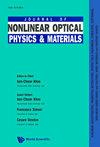Wet-jet milling exfoliated hexagonal boron nitride as industrial anticorrosive pigment for polymeric coatings
IF 2.3
4区 物理与天体物理
Q2 OPTICS
引用次数: 2
Abstract
The incorporation of inorganic nanofillers into polymeric matrices represents an effective strategy for the development of smart coatings for corrosion protection of metallic substrates. In this work, wet-jet milling exfoliation was used to massively produce few-layer hexagonal boron nitride (h-BN) flakes as a corrosion-protection pigment in polyisobutylene (PIB)-based composite coatings for marine applications. This approach represents an innovative advance in the application of two-dimensional (2D) material-based composites as corrosion protection systems at the industrial scale. Although rarely used as an organic coating, PIB was selected as a ground-breaking polymeric matrix for our h-BN-based composite coating thanks to its excellent barrier properties. The optimization of the coating indicates that 5 wt.% is the most effective h-BN content, yielding a corrosion rate of the protected structural steel as low as 7.4 × 10−6 mm yr−1. The 2D morphology and hydrophobicity of the h-BN flakes, together with the capability of PIB to act as a physical barrier against corrosive species, are the main reasons behind the excellent anticorrosion performance of our composite coating.湿喷磨脱片状六方氮化硼用于聚合物涂料的工业防腐颜料
将无机纳米填料掺入聚合物基体中,是开发用于金属基体防腐蚀的智能涂层的有效策略。在这项工作中,湿射流铣削剥落被用于大规模生产少层六方氮化硼(h-BN)薄片,作为船用聚异丁烯(PIB)基复合涂料的防腐颜料。这种方法代表了二维(2D)材料基复合材料作为工业规模防腐系统应用的创新进展。虽然很少用作有机涂层,但由于其优异的阻隔性能,PIB被选为h- bn基复合涂层的突破性聚合物基体。涂层优化表明,5 wt.%的h-BN含量是最有效的,使受保护结构钢的腐蚀速率低至7.4 × 10−6 mm yr−1。h-BN薄片的二维形态和疏水性,以及PIB作为腐蚀物质的物理屏障的能力,是我们的复合涂层具有优异防腐性能的主要原因。
本文章由计算机程序翻译,如有差异,请以英文原文为准。
求助全文
约1分钟内获得全文
求助全文
来源期刊
CiteScore
3.00
自引率
48.10%
发文量
53
审稿时长
3 months
期刊介绍:
This journal is devoted to the rapidly advancing research and development in the field of nonlinear interactions of light with matter. Topics of interest include, but are not limited to, nonlinear optical materials, metamaterials and plasmonics, nano-photonic structures, stimulated scatterings, harmonic generations, wave mixing, real time holography, guided waves and solitons, bistabilities, instabilities and nonlinear dynamics, and their applications in laser and coherent lightwave amplification, guiding, switching, modulation, communication and information processing. Original papers, comprehensive reviews and rapid communications reporting original theories and observations are sought for in these and related areas. This journal will also publish proceedings of important international meetings and workshops. It is intended for graduate students, scientists and researchers in academic, industrial and government research institutions.

 求助内容:
求助内容: 应助结果提醒方式:
应助结果提醒方式:


